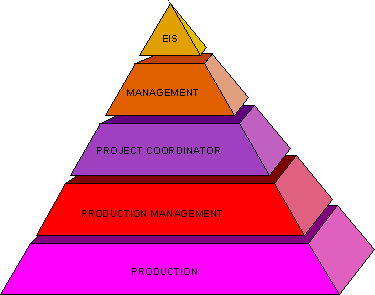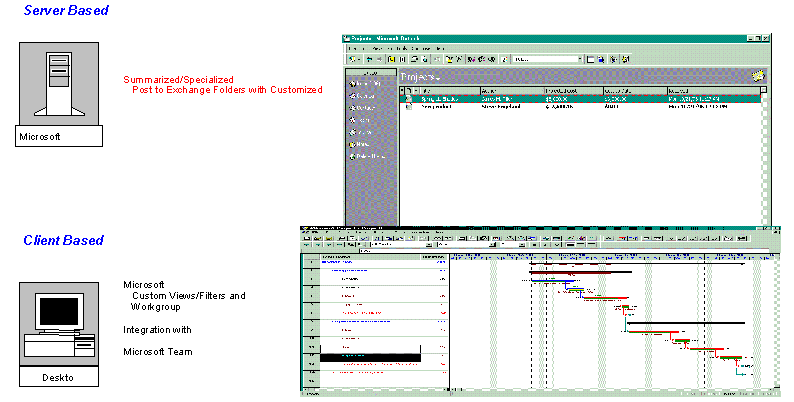
Presented by: James M. Piller
Margolin, Winer & Evens LLP
Jim Piller is a Microsoft Solution Provider specializing in project management and enterprise-based solutions. He has migrated many organizations to Microsoft® BackOffice™ family and desktop solutions over the past 10 years using his knowledge of project management, Microsoft tools, and the corporate business environment.
Phone: (516)747-6665
Fax: (516)747-6707
Email: Jpiller@mwellp.com
Project management and its ability to track, time, resources and value, has become an indispensable tool for the corporate enterprise. The corporate enterprise can be as diverse as an information technology (IT) organization planning development of new software or implementation of new architecture; a cosmetics company’s research and development and manufacturing tracking the development of a new product from market research through release; a major financial institution planning its merger with another, tracking all business unit consolidations and federal reporting; or a fiber-optic telecommunications designer tracking the progress of manufacturing and installation against contractual obligations. All these companies seek a common result from their project management solution-a multitiered enterprise-wide information perspective.
To find out how this came about, you must examine the evolution of project management and the Microsoft Project project planning software within the organization. Project management tools entered organizations on an ad-hoc basis. Employees needed a tool that could help them manage their projects and facilitate reporting. For the most part they were skilled in the knowledge of their particular organization and job responsibility, but knew little about project management, Gantt charts, etc. They needed a tool that made it simple and gave them the information they required, without requiring excessive time to learn or maintain. PC-based project management software fulfilled that need and allowed these users to present concise, detailed reports depicting critical information and the status of their projects.
Management viewed these isolated project management reports with great interest and promoted the implementation of project as a global solution. Soon there were dozens of project plans being produced and passed onto management, often with greater detail then was necessary. Management needed a way to scale the reporting and provide a tiered project management solution. At the same time, an effective mechanism for resource sharing (preferably with real-time updating) was needed.
Microsoft Project, which started off as a powerful single-user solution, needed to be scaled and customized for management reporting. It needed to provide easily deciphered information in a format that was usable by both project and nonproject management personnel, often reporting across many divisions and groups.
When you examine the participants in an enterprise-wide solution you must consider the diversity and skill sets throughout the enterprise, in addition to the requirements for information at various levels. Understanding skill sets is important from the standpoint that traditional and nontraditional project managers are often involved in the process, and the solution needs to be designed for the diversity of the users. The chart below depicts this stratification of information, the bottom representing the most detailed information, lessening as it moves upward:

This group includes the actual performers and resources of the tasks in a project plan. These people are usually removed from the project planning process and are merely assigned the work. Their requirements for information can be satisfied by the Microsoft Project Workgroup functionality or using Team Manager Integration.
This group needs to see compiled information regarding the performers and resources that report to them. In some cases this is the project manager function. However, more often it is the department or division manager that needs to see information regarding their direct reports. This requirement for information can be addressed using the reporting available in Microsoft Project or Team Manager.
This group includes the individual responsible for the overall project. This may or may not be the project manager, but the function is similar. Ultimate responsibility for all project matters and the reporting thereof is the responsibility of this group. This person requires information gathered from all the resources, but with less detail. All information regarding progress, etc., is reportable through Microsoft Project.
This group relies on the information from the project coordinator to provide status and issue resolution. Management needs summarized information with less detail than the project coordinator yet more than is available in the Executive Information System (EIS). This group also will combine the project data with other data available in the organization.
This group looks at well-summarized data. They require up-to-date specific information. The extensibility of Microsoft Project-specifically, integration with the Microsoft Access database or the Microsoft Exchange Server client-server messaging and groupware-can provide the necessary information for an Executive Information System.

A common scenario can be implemented using the Microsoft Office office suite of applications. The following solution can provide for a simplified enterprise management solution.
Corporations are seeking new mechanisms for tracking and reporting information. The rightsizing phenomenon has created a more streamlined operation with a greater need to access to information throughout the corporation. Multiple management levels within the organization have a need to view information, in various levels of detail, to properly perform their jobs.
This information is dependent upon much of the knowledge base contained within Microsoft Project as well as information that complements the project database. Microsoft Project is a central repository for most of this information, because it tracks critical business data dealing with costs and timelines that various levels of the enterprise rely on.
The importance of Microsoft Project data and the ability to disseminate this data throughout the enterprise becomes critical as an organization tracks information throughout a project lifecycle. As various management levels seek the information, a mechanism needs to be employed. This mechanism must be simple to use, yet powerful enough to provide for all the requirements.
If you combine Microsoft’s tools, you can create an enterprise solution for information dissemination. Microsoft Project is the core for this information-sharing solution. The ability for Microsoft Project to post to Microsoft Exchange folders allows us to create customized views relating key project data. The integration of Microsoft Project with Team Manager helps you to further extend the solution to departmental levels and individual resources as well. If you need to integrate with external data you can use Microsoft Access or the SQL Server™ client-server database management system. Microsoft tools combined with Solution Providers skills can provide the foundation for a corporate project-based solution.
© 1997 Microsoft Corporation. All rights reserved.
The information contained in this document represents the current view of Microsoft Corporation on the issues discussed as of the date of publication. Because Microsoft must respond to changing market conditions, it should not be interpreted to be a commitment on the part of Microsoft, and Microsoft cannot guarantee the accuracy of any information presented after the date of publication.
This document is for informational purposes only. MICROSOFT MAKES NO WARRANTIES, EXPRESS OR IMPLIED, IN THIS SUMMARY.
Microsoft is a registered trademark and BackOffice is a trademark of Microsoft Corporation.
Other product or company names mentioned herein may by the trademarks of their respective owners.